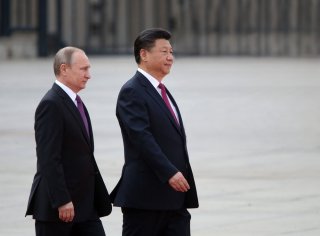What History, China, and Culture Tell Us About Ending the Ukraine War
China and Russia’s foreign policies spring from deep historical contexts.
Historically positioned as a bridge between Eastern and Western Europe, Ukraine has repeatedly been trapped in geopolitical power struggles. Russia’s 2014 annexation of Crimea harkens back to Cold War dynamics, where clear spheres of influence were established, and deviations were met with either direct force or the threat of it. The current conflict reignites—for those old enough to remember or those interested in history—memories of the Cuban Missile Crisis, the Berlin Wall, and the disintegration of Yugoslavia, serving as stark reminders of a fragile equilibrium in Europe that has frequently been on the verge of shattering.
Washington’s backing of Ukraine today isn’t simply an act of benevolence. It’s a strategic maneuver in the intricate game of geopolitics. Post-World War II, the United States has consistently sought to prevent any single power from asserting dominance over Europe. Initiatives like the Marshall Plan, the inception of NATO, and interventions in the Balkans during the 1990s all aimed to uphold this balance. Russia’s significant influence in Eastern Europe disrupts this equilibrium, potentially granting Moscow considerable sway over Europe’s energy corridors and trade pathways. This is an unsettling prospect for Washington, committed to preserving a balanced power dynamic in Europe.
While not directly involved, NATO’s stance, which strongly supports Ukraine, underscores the alliance’s core tenet: an assault on one member is an assault on all. Even though Ukraine isn’t part of NATO, the alliance’s vested interest in the region is evident. A resurgent Russia, fortified by unchecked territorial gains and a deepening partnership with China, realistically threatens (from NATO’s perspective) NATO’s eastern flank, echoing Soviet-era aggressions. Ukraine may have been ambivalent before, but it is now painfully aware of this geopolitical situation. It has not just applied to join NATO but amended its Constitution to set an explicit national goal for Ukraine to join NATO and the European Union.
Yet, Russia’s actions aren’t just spurred by expansionist desires. Historical events, like the encroachments by Napoleon and Hitler through Eastern Europe, have ingrained a sense of vulnerability in the Russian strategic mindset. For Moscow, maintaining Ukraine as a neutral or allied entity isn’t merely strategic but a historical necessity. From Moscow’s point of view, if Ukraine isn’t integrated into Moscow’s security framework by diplomacy, then it must be done by force.
Drawing cultural parallels, consider Russia’s neighbor, China, and its “Century of Humiliation.” As a British-Chinese American, I’ve seen how this tumultuous period has profoundly impacted the Chinese psyche. Comfortably one of the world’s leading economies for nearly two millennia, China’s illustrious empire fell into decay and experienced fragmentation at the hands of Western and Japanese imperialism. It soon descended into civil war. The brutalities of this historical trauma are on the minds of Chinese leadership and significantly influence China’s modern foreign policy, evident in China’s assertive actions in the South China Sea and stance on Taiwan.
Similarly, Russia’s history is marred by invasions from various conquerors. From Mongol subjugation to confrontations with Napoleon and Hitler, Russia has frequently been on the back foot, fostering a pervasive sense of vulnerability. Like its neighbor China, it went from being one of Europe’s preeminent intellectual, military, and cultural powers envied by the courts of Europe to what is considered today a largely corrupt country at risk of becoming a failed state. This historical backdrop shapes Russian leadership’s current geopolitical decisions, from Crimea’s annexation to its apprehensions about NATO’s expansion. Just as China’s historical traumas inform its contemporary policies, Russia’s past imbues it with a desire for protective buffers and influence zones in a world where it perceives threats at its doorstep.
Navigating the complexities of conflict means recognizing intertwined human and cultural narratives. It’s easy for pundits, politicians, and legislators alike to throw academic international relations theory gained in college into the mix and call it a day. But Russians, just like any other civilization, are shaped by dreams, anxieties, and a profound national identity rooted in an equally complex history. Russian leadership is also molded by Russia’s historical tapestry. They are, in short, human beings acting out of anxious self-interest and insecurity.
Washington-style realpolitik has its place, but resolving the Ukraine conflict demands more than overpaid high-level braggadocio in Washington, Brussels, or Moscow using taxpayer money. It requires acknowledging the shared histories and aspirations that have bound nations for ages. Effective diplomacy must transcend mere strategic calculus, embracing the shared histories and human connections that have interwoven the destinies of Russia and Ukraine.
The Ukraine conflict is not without precedent and will end in two ways. If leadership acts responsibly, which means with an awareness of history and culture, it may likely be resolved through a combination of diplomacy, international pressure, and evolving geopolitical landscapes. We may have a ceasefire, and the war will be diffused over time. If not, the consequences are dire for everyone. Unchecked escalation will plunge the region into a prolonged period of instability, drawing in major powers and potentially leading to a larger conflict. Failure to address the conflict emboldens states with expansionist ambitions, setting a dangerous precedent, and the specter of a new Cold War, marked by proxy battles and an arms race, suddenly becomes a grim reality.
Symington W. Smith is a member of the National Committee on U.S.-China Relations.
Image: Shutterstock.

